Ancient Armenia › Troy » Ancient origins
Articles and Definitions › Contents
- Ancient Armenia › Antique Origins
- Troy › Ancient History
Ancient civilizations › Historical and archaeological sites
Ancient Armenia › Antique Origins
Definition and Origins

Ancient Armenia, located in the south Caucasus area of Eurasia, was settled in the Neolithic era but its first recorded state proper was the kingdom of Urartu from the 9th century BCE. Incorporated into the Persian Empire of Cyrus the Great in the 6th century BCE, the Orontid dynasty ruled as Persian satraps, a function they performed for their next overlords the Macedonians and Seleucid Empire into the 3rd century BCE. Under the Artaxiad and Arsacid dynasties the country flourished but was often caught between the ambitions of Parthia and Rome, and then the Sasanian and Byzantine Empires. The boundaries of the state varied considerably over the centuries but such common factors as religion and language were united by long-lasting dynastic clans, which gave Armenia its own unique identity throughout antiquity.
HAYASA-AZZI (1500-1200 BCE)
The first identifiable culture in the region is the Hayasa-Azzi, an indigenous tribal confederation which flourished on the fertile plateau of ancient Armenia around Mount Ararat and parts of modern-day eastern Turkey between c. 1500 and c. 1200 BCE.The Hayasa-Azzi are the eponym of the Hay people, the term Armenians use to describe themselves and their state, Hayastan. Over time, the Hayasa-Azzi mixed with other ethnic groups and local tribes such as the Hurrians, Arme-Shupria, and Nairi, probably motivated by the need for defence against more aggressive and powerful neighbours like the Hittites and the Assyrians. They were probably infiltrated by the Thraco-Phrygians following the collapse of the Hittite Empire c. 1200 BCE. Eventually, these various peoples and kingdoms would be fused into the region's first recognisable and recorded state, the kingdom of Urartu from the 9th century BCE.
URARTU (9TH CENTURY BCE - C. 590 BCE)
Names
Urartu, also known as the Kingdom of Van after the lake in the region of the same name, developed as a federation of older and smaller kingdoms across Armenia, eastern Turkey, and northwestern Iran. 'Urartu' comes from urashtu, the Assyrian word for the kingdom, and signifies “high place”, possibly referring to either the mountainous region or the culture's common practice of building fortifications on rock promontories. The Urartians called themselves the Biaina.
Geography & Expansion
Urartu prospered thanks to settlement on the extensive fertile plateau which was well-supplied by rivers. Viticulture was important, wine-making in the region perhaps being the earliest anywhere. Animal husbandry prospered thanks to excellent mountain pastures, and horses, especially, were bred with success. Mineral deposits in the area included gold, silver, copper, lead, iron, and tin and were all used to produce highly skilled metalwork, especially bronze cauldrons. The location on the trade routes between the ancient Mediterranean and Asian and Anatolian cultures was another source of prosperity.
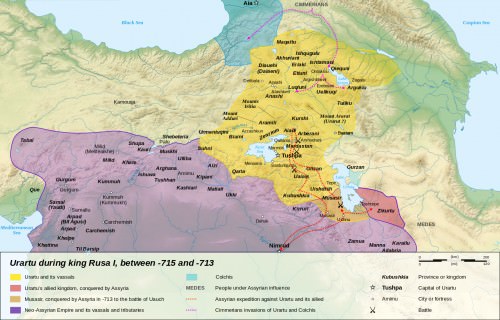
Urartu 714-715 BCE
The fortress capital was Tushpa (later called Van), built on a limestone promontory on the eastern shores of Lake Van in the highlands. Regional governors represented the king and channelled taxes back to the capital. In 776 BCE, Argishti I (rc 785-760 BCE) founded a new city, Argishtihinili, on the Plain of Ararat, later to become the second city of the kingdom and renamed Armavir. Then, c. 685 BCE, king Rusa II (rc 685-645 BCE) founded the important northern city of Teishebaini(modern Yerevan), also on the Ararat plain. An important fortress site with substantial remains today is Erebuni near today's capital of Armenia, Yerevan.
The pantheon of the Urartu religion contains a mix of unique and Hurrian gods such as the god of storms and thunder Teisheba, from the Hurrian Teshub. The mid-9th-century BCE king Ishpuini promoted Haldi (Khaldi) to the head of the gods, a deity of foreign origin and associated with warfare. So important was this god that the Urartians were sometimes called the Haldians or “children of Haldi”. The various gods were offered libations and animal sacrifices as well as dedications of weapons and precious goods.
Early Urartu writing used simple pictograms, but cuneiform was adopted and adapted from neighbouring contemporary Mesopotamian cultures. Surviving cuneiform inscriptions from the kingdom show that the Urartian language was related to Hurrian.
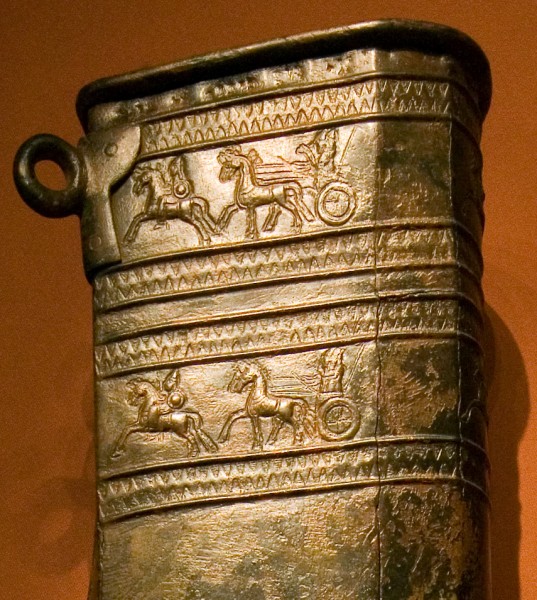
Urartu Decorated Quiver
By the 7th century BCE, Urartu controlled a territory which stretched from the Caspian Sea to the Upper Euphrates (east to west) and the Caucasus mountains in the north to the Taurus Range in the south. The chief adversary of Urartu was the Neo-Assyrian Empire, although there is also evidence of trade relations between the two states. The Assyrian ruler Tiglath-Pileser III (r. 745-727 BCE) was especially aggressive, and he laid siege to Tushpa. Another significant conflict between the two states was during the campaign of Sargon II (722-705 BCE) in 714 BCE.
Decline
The Urartu kingdom came to a violent end when sometime between c. 640 and c. 590 BCE its cities were destroyed.Weakened by decades of battles with the Assyrians, it may have been too overstretched to control its own empire. The perpetrators are not known, but the Scythians are one candidate, the Cimmerians another, and even possibly forces from within the territories administered by the Urartu kings. The kingdom was taken over by the Medes from c. 585 BCE onwards and then incorporated into the Achaemenian Empire of Cyrus the Great in the mid-6th century BCE.
THE FIRST KNOWN MENTION OF THE PERSIAN CLIENT STATE OF ARMENA OR ARMENIA IS RECORDED IN A C. 520 BCE INSCRIPTION OF DARIUS I.
ORONTID DYNASTY (C. 570 - C. 200 BCE)
Persian Satraps
The Orontid dynasty succeeded the Kingdom of Urartu in ancient Armenia and ruled from the 6th to 3rd century BCE. The founder of the royal dynasty of the Orontids was Orontes (Yervand) Sakavakyats (c. 570-560 BCE, although reign dates for most of the Orontids are disputed). Initially, the Orontids ruled as Persian satraps as the Achaemenians divided their new territory into two parts, and it was in the eastern province that the Orontid dynasty, known locally as the Yervand (from the Iranian word arvand, meaning “mighty”), ruled as satraps on behalf of their Persian overlords. Thus, Persian culture, language and political practices were introduced into ancient Armenia which still maintained its own Urartian traditions, too.
The first known mention of the Persian client state of Armena or Armenia is recorded in a c. 520 BCE inscription of Darius I (r. 522-486 BCE) on a rock face in Behistun, Persia, which lists the king's royal possessions in Old Persian. The old Urartian capital of Van was also the first capital of the Orontids. An attempt to secede from the Persian Empire in 522 BCE was short-lived, Armenia being too valuable a source of soldiers and tribute, especially horses. Life under Persian rule seems to have been at least tolerable and Armenian culture left to largely follow its own path. By the mid-4th century BCE, the two divided regions under Persian control had been politically merged, their populations had mixed, and the language had become one: Armenian.
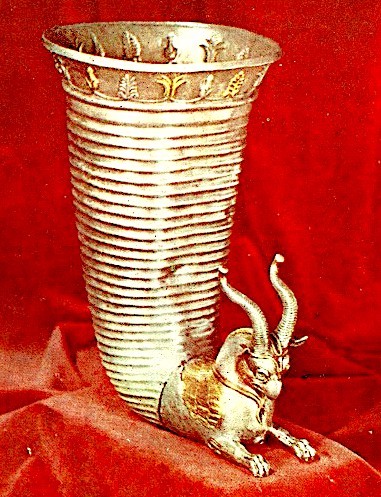
Silver Orontid Rhyton
Macedonian Empire
Following the rise of Alexander the Great, Armenia was formally annexed by Macedon, and in 330 BCE Armavir was made the capital (the former Urartian city of Argishtihinili). It seems likely that the political rule of Armenia remained much as under the Persians, though, with the Orontids ruling as semi-independent kings within the now vast Macedonian Empire. Indeed, even the Armenian rulers struggled to control the powerful local lords, known as nakharars and forming a hereditary nobility, such was the “feudal” nature of the region at this time.
THE SELEUCIDS GOVERNED ARMENIA, LEADING TO A CERTAIN HELLENIZATION, WHICH CREATED A RICH CULTURAL MIX OF ARMENIAN, PERSIAN & GREEK ELEMENTS.
Seleucid Empire
From 321 BCE the Seleucids governed the Asian portion of Alexander ’s empire after the young leader's death, leading to a certain Hellenization, which created a rich cultural mix of Armenian, Persian, and Greek elements. Such was the size of the Seleucid Empire that the Orontid rulers were, again, largely left to enjoy a good deal of autonomy in what was now a region with three distinct areas: Lesser Armenia (to the northwest, near the Black Sea), Greater Armenia (the traditional heartland of the Armenian people) and Sophene (aka Dsopk, in the southwest). The Orontid kings' independence is illustrated by the minting of their own coinage.
Antiochus III & Decline
Around 260 BCE the newly unified kingdom of Commagene and Sophene arose in western Armenia, governed by Sames (aka Samos ), a ruler of Orontid descent. It was Sames (rc 260-240 BCE) who founded the important city of Samosata (Shamshat).The period also saw the resurgence of the Persians and the growth of the Parthian Empire (247 BCE - 224 CE), who now claimed sovereignty over Armenia. However, the Seleucid king Antiochus III (r. 222-187 BCE) reasserted control over Armenia and notably extracted 300 talents of silver and 1,000 horses for his armies as they passed through the region on their way to suppress the Parthians.
The last of the Orontid dynasty to rule in eastern Armenia was King Orontes IV (aka Yervand the Last, rc 212-200 BCE).Yervand moved the capital from Armavir to the newly founded Yervandashat. His successor, following the king's murder, was the founder of the next dynasty to dominate Armenia in the coming centuries, King Artaxias I (Artashes) who was backed and made a direct satrap by Antiochus III, probably in a move to reduce the trend of Armenian independence in recent decades.
ARTAXIAD DYNASTY (C. 200 BCE - 12 CE)
Artaxias I
Antiochus III did not just change the ruling house of Armenia, he created two satraps: Artaxias I (rc 200 - c. 160 BCE) in Armenia and Zariadris in the smaller kingdom of Sophene to the southwest. When Antiochus was defeated by the Romans at the Battle of Magnesia in 190 BCE, Artaxias declared himself king and set about expanding his kingdom, which he consolidated via an administrative centralisation and such innovations as boundary stelae to proclaim property rights and the authority of the crown. A new capital was founded at Artaxata ( Artashat ) in 176 BCE. Hannibal, the great Carthaginian general, was said to have designed the city's fortifications when he served Artaxias following his defeat to the Romans.
When Artaxias I died, he was succeeded by his sons and the Artaxiad dynasty (aka Artashesian dynasty) was established.Armenia then enjoyed a sustained period of prosperity and regional importance but it would also be perpetually squeezed between the region's two superpowers: Parthia and Rome. Both would take turns in putting forward their own candidate to rule Armenia, which became a buffer zone between the two empires.

Empire of Tigranes the Great
Tigranes the Great
One of the greatest of Artaxiad kings, or indeed any Armenian king, was Tigranes II (Tigran II) or Tigranes the Great (rc 95 - c. 56 BCE). He expanded the Armenian kingdom considerably; first, he annexed the kingdom of Sophene in 94 BCE. Then, with formidable siege engines and units of heavily-armoured cavalry, he conquered Cappadocia, Adiabene, Gordyene, Phoenicia, and parts of Syria, including Antioch. The Armenian king even sacked Ecbatana, the Parthian royal summer residence, in 87 BCE while the Parthians were struggling to deal with invading northern nomads. At its peak, Tigranes the Great's Armenian Empire stretched from the Black Sea to the Mediterranean. Not before or since would Armenians control such a huge swathe of Asia.
Tigranes called himself the "king of kings" from 85 BCE, and he founded a new capital city in 83 BCE, Tigranocerta (aka Tigranakert, and of uncertain location) which was famously Hellenistic in its architecture. The Greek language was likely used, along with Persian and Aramaic, as the language of the nobility and administration while commoners spoke Armenian. Persian elements continued to be an important part of the Armenian cultural mix, too, especially in the area of religion.
FOLLOWING A ROMAN ATTACK C. 66 BCE LED BY POMPEY THE GREAT, ARMENIA WAS MADE INTO A ROMAN PROTECTORATE.
Roman-Parthian Wars & Decline
Tigranes allied himself with Mithridates VI, the king of Pontus (r. 120-63 BCE) whose daughter he married. The Roman Republic, seeing the danger of such an alliance between the two regional powers, responded by attacking Pontus, and when Mithridates fled to the court of Tigranes in 70 BCE, the Romans invaded Armenia. Tigranocerta was captured in 69 BCE, and the Armenian king was forced to abandon his conquests. Following another Roman attack c. 66 BCE, this time led by Pompeythe Great, Armenia was made into a Roman protectorate. The Artaxiads continued to rule but were obliged to involve themselves in the Roman-Parthian wars, providing troops for both Marcus Licinius Crassus in 53 BCE and Mark Antony in 36 BCE. The latter general, dissatisfied with Armenian support, attacked the kingdom in 34 BCE and took the king, Artavasdes II (rc 56-34 BCE), to Alexandria where he would later be executed by Queen Cleopatra. A game of musical thrones then followed with first a Roman-backed king in Armenia, and then a Parthian-backed candidate until a new family took over the throne in 12 CE, the Arsacid (Arshakuni) dynasty.
ARSACID DYNASTY (12 CE - 428 CE)
Tiridates I
The founder of the Arsacid dynasty was Vonon (Vonones), but as he was succeeded by several short-ruling kings, some historians consider the founder proper of the dynasty to be Tiridates I of Armenia (r. 63 - 75 or 88 CE). He was the brother of the Parthian king Vologases I (rc 51-78 CE) who invaded Armenia in 52 CE for the specific purpose of setting Tiridates on the throne. The Romans were not content to let Parthia into their buffer zone, and in 54 CE, Emperor Nero (r. 54-68 CE) sent an army under his best general Gnaeus Domitius Corbulo. A decade of intermittent warfare, which saw such important Armenian cites as Artaxata and Tigranocerta captured, ended in the 63 CE Treaty of Rhandia. It was now agreed that Parthia had the right to nominate Armenian kings but Rome the right to crown them. Nero was thus given the privilege of crowning Tiridates in Rome in a lavish spectacle.
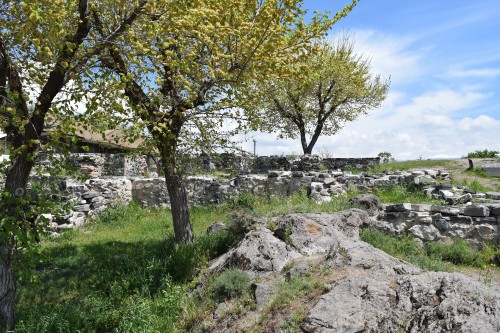
Ruins of Roman Baths at Garni Temple
Roman Interventions
Vespasian (r. 69-79 CE) made sure that no more territories would fall to the Parthian ruling dynasty by annexing the neighbouring kingdoms of Commagene and Lesser Armenia in 72 CE. A period of peace then followed until Emperor Trajan (r. 98-117 CE), using the excuse of not being consulted on a change in monarch, grabbed the moment and annexed Armenia for Rome. He then declared war on Parthia in 114 CE. Ultimately, Armenia was made a province of the Roman Empire and administered alongside Cappadocia.
Emperor Hadrian (r. 117-138 CE) was much less enthusiastic about keeping the bothersome province, and he allowed it to become independent. Various Parthian and Roman incursions occurred over the next century but Artaxata, at least, prospered after it was made one of the official trading points between the two empires.
Sasanian Empire
Following the rise of the Sasanid dynasty from 224 CE, there was a more aggressive Persian foreign policy towards Armenia which culminated in a full-scale invasion by the Sasanids in 252 CE. The Armenian Arsacid kings, with such close blood ties to the vanquished Arsacids in Persia, posed a threat of legitimacy to the new Sasanid order. The Sasanids won several major victories against Rome in this period, but the Romans were resurgent in the 4th century CE. When the dust finally settled again the kingdom of Armenia found itself divided up between Rome and Persia, with the Arsacids continuing to rule only western Armenia. In 298 CE, under the auspices of Diocletian (r. 284-305 CE), Armenia was unified with Tiridates IV (Trdat III or IV) as king (rc 298 - c. 330 CE) - one of the great rulers of the Arsacid dynasty.

Arsacid Armenia
Tiridates the Great & Christianity
Tiridates the Great set about centralising his kingdom and reorganising the provinces and their governors. Land surveys were also carried out to better identify tax obligations; the king was determined to make Armenia great once again. By far the most lasting event of this period was Armenian's official adoption of Christianity c. 314 CE, if not earlier. Tradition records that Tiridates himself was converted in 301 CE by Saint Gregory the Illuminator. One consequence of the move was that the persecution of the religion by Persia helped to create a more fiercely independent state. Saint Gregory, then known as Grigor Lusavorich, was made the first bishop of Armenia in 314 CE. Tiridates IV may also have adopted Christianity for internal political reasons - the end of the pagan religion was a fine excuse to confiscate the old temple treasuries and a monotheistic religion with the monarch as God's representative on earth might well instil greater loyalties from his nobles, the nakharars, and people in general.
THEODOSIUS I & SHAPUR III AGREED TO FORMALLY DIVIDE ARMENIA BETWEEN THE EASTERN ROMAN (BYZANTINE) EMPIRE & SASANID PERSIA.
Division & Decline
There was a greater threat from outside Armenia though, as the Sasanids again became more ambitious to rule directly over Armenia and made attacks on Armenian cities. It was then that emperor Theodosius I (r. 379-395 CE) and Shapur III (r. 383-388 CE) agreed to formally divide Armenia between the Eastern Roman (Byzantine) Empire and Sasanid Persia.
In 405 CE the Armenian alphabet was invented by Mesrop Mashtots and the Bible translated into that language, helping to further spread and entrench Christianity in Armenia. Politically, though, it was time for a change. The last Arsacid ruler was Artashes IV (r. 422-428 CE) after the Armenian crown, unable to repress the pro-Persian and anti-Christian factions at court, was abolished by Persia and viceroy rulers, the marzpans, were installed.
MAMIKONIAN DYNASTY (428-652 CE)
The Mamikonains
The last great dynasty to rule ancient Armenia was the Mamikonians who had been a powerful force in the Armenian military ever since the 1st century BCE. By the end of the 4th century CE the hereditary office of grand marshal ( sparapet ), who led the armed forces of Armenia, usually had a Mamikonian lord in the position. Amongst the other noble families the Mamikonians had been only second in importance to the Arsacid royal family itself, indeed two members had even served as regents: Mushegh and Manuel Mamikonian. Once the ruling house of Arsacid fell, the Mamikonians were left to dominate state affairs within the limitations imposed by their Persian overlords.
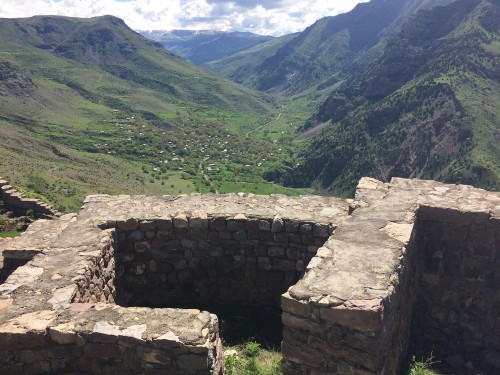
Armenia's Smbataberd Fortress
Persia & Avarayr
Persia installed marzpan rulers in their half of the country (Persarmenia) from 428 CE. Representing the Sasanian king, the marzpans had full civilian and military authority. There had been rumblings of discontent amongst the Armenian nobility and clergy following Persian cultural imperialism, but matters really came to a head with the succession of the Persian king Yazdgird (Yazdagerd) II in c. 439 CE. Sasanid rulers had long been suspicious that Armenian Christians were all simply spies of Byzantium, but Yazdgird was a zealous proponent of Zoroastrianism and the double-edged sword of political and religious policy was about to cut Armenia down to size.
In May or June 451 CE at the Battle of Avarayr (Avarair) in modern Iran, the Armenians rebelled against oppression and faced a massive Persian army. The 6,000 or so Armenians were led by Vardan Mamikonian, but unfortunately for them, help from the Christian Byzantine Empire was not forthcoming despite an embassy sent for that purpose. Perhaps not unexpectedly, the Persian-backed marzpan, Vasak Siuni, was nowhere to be seen in the battle either. The Persians, greatly outnumbering their opponents and fielding an elite corps of “Immortals” and a host of war elephants, won the battle easily enough and massacred their opponents; 'martyred' would be the term used by the Armenian Church, thereafter. Indeed, the battle became a symbol of resistance with Vardan, who died on the battlefield, even being made a saint.
Minor rebellions continued over the next few decades, and the Mamikonians continued a policy of careful resistance. The strategy paid off, for in 484 CE the Treaty of Nvarsak was signed between the two states, which granted Armenia a greater political autonomy and freedom of religious thought. In a full turnaround, Vahan, the nephew of Vardan, was made the marzpan in 485 CE. Peace brought prosperity and trade flourished as Artashat became an important trading point between the Byzantine and Persian Empires. Armenia was finding its feet as a unified nation, helped by language, the Christian faith, and such figures as Movses Khorenatsi ( Moses of Khoren) who wrote his History of the Armenians, the first comprehensive history of the country in the late 5th century CE.
The Umayyad Caliphate
Armenia's geographical position would, yet again, cause its downfall. By the end of the 6th century CE, Persia and the Byzantine Empire created yet another division which saw Byzantium acquire two-thirds of Armenia. Worse was soon to come, though, following the dramatic rise of a new power in the region, the Arab Umayyad Caliphate, which conquered the Sasanid capital Ctesiphon in 637 CE and Armenia between 640 to 650 CE. The country was formally annexed as an Umayyad province in 701 CE.
This article was made possible with generous support from the National Association for Armenian Studies and Researchand the Knights of Vartan Fund for Armenian Studies.
MAP
Troy › Ancient History
Definition and Origins
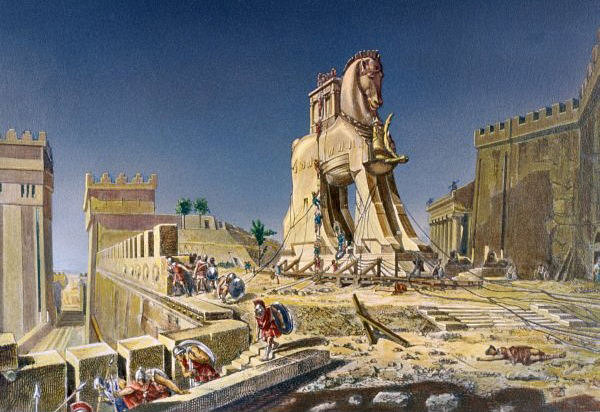
Troy is the name of the Bronze Age city attacked in the Trojan War, a popular story in the mythology of ancient Greece, and the name given to the archaeological site in the north-west of Asia Minor (now Turkey ) which has revealed a large and prosperous city occupied over millennia. There has been much scholarly debate as to whether mythical Troy actually existed and if so whether the archaeological site was the same city; however, it is now almost universally accepted that the archaeological excavations have revealed the city of Homer ’s Iliad. Other names for Troy include Hisarlik (Turkish), Ilios (Homer), Ilion ( Greek ) and Ilium ( Roman ).
TROY IN MYTH
Troy is the setting for Homer's Iliad in which he recounts the final year of the Trojan War sometime in the 13th century BCE.The war was in fact a ten-year siege of the city by a coalition of Greek forces led by King Agamemnon of Mycenae. The purpose of the expedition was to reclaim Helen, wife of Menelaos, king of Sparta and brother of Agamemnon. Helen was abducted by the Trojan prince Paris and taken as his prize for choosing Aphrodite as the most beautiful goddess in a competition with Athena and Hera. The Trojan War is also told in other sources such as the Epic Cycle poems (of which only fragments survive) and is also briefly mentioned in Homer's Odyssey. Troy and the Trojan War later became a staple myth of Classical Greek and Roman literature.
IN THE ILIAD, HOMER DESCRIBES TROY AS 'WELL-FOUNDED', 'STRONG-BUILT' & 'WELL-WALLED'.
Homer describes Troy as 'well-founded', 'strong-built' and 'well-walled'; there are also several references to fine battlements, towers and 'high' and 'steep' walls. The walls must have been unusually strong in order to withstand a ten-year siege and in fact, Troy fell through the trickery of the Trojan horse ruse rather than any defensive failing. Indeed, in Greek mythology the walls were so impressive that they were said to have been built by Poseidon and Apollo who after an act of impiety were compelled by Zeus to serve the Trojan king Laomedon for one year. However, the fortifications did not help the king when Herakles sacked the city with an expedition of only six ships. The sacking was Herakles' revenge for not being paid for his services to the king when he killed the sea-serpent sent by Poseidon. This episode was traditionally placed one generation before the Trojan War as the only male survivor was Laomedon's youngest son Priam, the Trojan king in the later conflict.
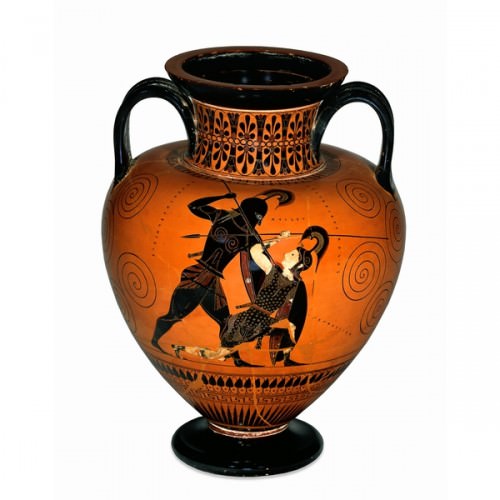
Black-figured amphora (wine-jar) signed by Exekias as potter and attributed to him as painter
TROY IN ARCHAEOLOGY
Inhabited from the Early Bronze Age (3000 BCE) through to the 12th century CE the archaeological site which is now called Troy is 5 km from the coast but was once next to the sea. The site was situated in a bay created by the mouth of the river Skamanda and occupied a strategically important position between Aegean and Eastern civilizations by controlling the principal point of access to the Black Sea, Anatolia and the Balkans from both directions by land and sea. In particular, the difficulty in finding favourable winds to enter the Dardanelles may well have resulted in ancient sailing vessels standing by near Troy. Consequently, the site became the most important Bronze Age city in the North Aegean, reaching the height of its prosperity in the middle Bronze Age, contemporary with the Mycenaean civilization on the Greek mainland and the Hittiteempire to the East.
Troy was first excavated by Frank Calvert in 1863 CE and visited by Heinrich Schliemann who continued excavations from 1870 CE until his death in 1890 CE; in particular, he attacked the conspicuous 20 m high artificial mound which had been left untouched since antiquity. Initial finds by Schliemann of gold and silver jewellery and vessels seemed to vindicate his belief that the site was actually the Troy of Homer. However, these have now been dated to more than a thousand years before a probable date for the Trojan War and indicated that the history of the site was much more complex than previously considered.Indeed, perhaps unwittingly, Schliemann would add 2000 years to Western history, which had previously gone back only as far as the first Olympiad of 776 BCE.
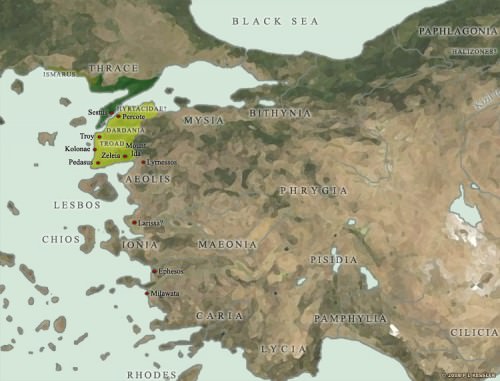
Map of the Trojan War States, c. 1200 BCE
The excavations continued throughout the 20th century CE and continue to the present day and they have revealed nine different cities and no less than 46 levels of inhabitation at the site. These have been labelled Troy I to Troy IX after Schliemann's (and his successor Dorpfeld's) original classification. This has since been slightly adjusted to incorporate radio-carbon dating results from the early 21st century CE.
Troy I (c. 3000-2550 BCE) was a small village settlement surrounded by stone walls. Pottery and metal finds match those on Lesbos and Lemnos in the Aegean and in northern Anatolia.
Troy II (c. 2550-2300 BCE) displays larger buildings (40 m long), mud-brick and stone fortifications with monumental gates.Schliemann's 'treasure' finds - objects in gold, silver, electrum, bronze, carnelian and lapis lazuli - most likely come from this period. This 'treasure' includes 60 earrings, six bracelets, two magnificent diadems and 8750 rings, all in solid gold. Once again, finds of foreign materials suggest trade with Asia.
Troy III - Troy V (c. 2300-1750 BCE) is the most difficult period to reconstruct as the layers were hastily removed in early excavations in order to reach the lower levels. Generally speaking, the period seems a less prosperous one but foreign contact is further evidenced by the presence of Anatolian influenced dome ovens and Minoan pottery.
THE ARCHAEOLOGICAL SITE OF TROY HAS IMPRESSIVE FORTIFICATION WALLS 5 M THICK & UP TO 8 M HIGH CONSTRUCTED FROM LARGE LIMESTONE BLOCKS.
Troy VI (c. 1750-1300 BCE) is the period most visible today at the site and is the most likely candidate for the besieged city of Homer's Trojan War. Impressive fortification walls 5 m thick and up to 8 m high constructed from large limestone blocks and including several towers (with the rectangular plan as in Hittite fortifications) demonstrate the prosperity but also a concern for defence during this period. The walls would have once been topped by a mud brick and wood superstructure and with closely fitting stonework sloping inwards; as the walls rise they certainly fit the Homeric description of 'strong-built Troy'. In addition, sections of the walls are slightly offset every 10 m or so in order to curve around the site without the necessity for corners (a weak point in wall defence). This feature is unique to Troy and displays an independence from both Mycenaean and Hittite influence. The walls included five gateways allowing entrance to the inner city composed of large structures, once of two stories and with central courts and collonaded halls similar to those of contemporary Mycenaean cities such as Tiryns, Pylos and Mycenae itself. Outside the fortified citadel the lower town covers an impressive 270,000 square metres protected by an encircling rock-cut ditch. The size of the site is now much bigger than first thought when Schliemann excavated and suggests a population of as high as 10,000, much more in keeping with Homer's grand city-state.
Finds at the site point to the existence of a thriving wool industry and the first use of horses, recalling Homer's oft-used epithet 'horse-taming Trojans'. Pottery very similar to that on the Greek mainland has been discovered, principally the Grey Minyan ware which imitates metal vessels. There are also imported ceramics from Crete, Cyprus and the Levant. In marked contrast to Mycenaean palaces, there is no evidence of sculpture or fresco-painted walls.
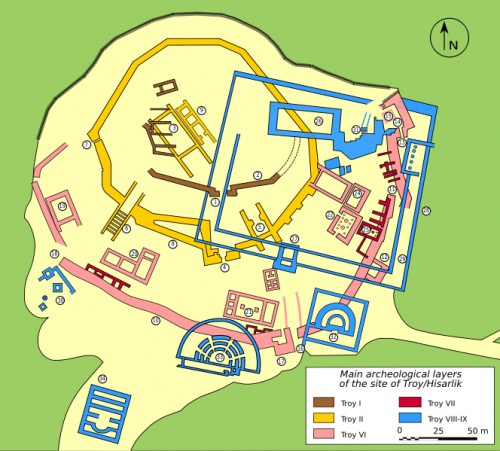
Map of Troy
Troy VI was partially destroyed but the exact cause is not known beyond some evidence of fire. Intriguingly, bronze arrow heads, spear tips and sling shots have been found on the site and even some embedded in the fortification walls, suggesting some sort of conflict. The dates of these (c. 1250 BCE) and the site destruction correlate with Herodotus ' dates for the Trojan War. Conflicts over the centuries between Mycenaeans and Hittites are more than probable and may well have been the origin of the epic Trojan War in Greek mythology. There is very little evidence of any large-scale war but the possibility of smaller conflicts is evidenced in Hittite texts where 'Ahhiyawa' is recognised as referring to Mycenaean Greeks and 'Wilusa' as the region of which Ilios was the capital. These documents tell of local unrest and Mycenaean support of local rebellion against Hittite control in the area of Troy and suggest a possible motive for regional rivalry between the two civilizations. Intriguingly, there is also a bronze Mycenaean sword taken as war booty and found in Hattusa, the Hittite capital.
Troy VIIa (c. 1300-1180 BCE) and Troy VIIb (c. 1180-950 BCE) both display an increase in the size of the lower town and some reconstruction of the fortifications but also a marked decline in architectural and artistic quality in respect to Troy VI. For example, there is a return to handmade pottery after centuries of wares made on the wheel. Once again, this correlates well with the Greek tradition that following the Trojan War the city was sacked and abandoned, at least for a time. Both Troy VIIa and Troy VIIb were destroyed by fires.
Troy VIIa (c. 1300-1180 BCE) and Troy VIIb (c. 1180-950 BCE) both display an increase in the size of the lower town and some reconstruction of the fortifications but also a marked decline in architectural and artistic quality in respect to Troy VI. For example, there is a return to handmade pottery after centuries of wares made on the wheel. Once again, this correlates well with the Greek tradition that following the Trojan War the city was sacked and abandoned, at least for a time. Both Troy VIIa and Troy VIIb were destroyed by fires.
Troy VIII and Troy IX (c. 950 BCE to 550 CE) are the sites of Greek Ilion and Roman Ilium respectively. There is evidence that the site was populated throughout the so-called Dark Ages but the settlement did not return to a level of significant development until the 8th century BCE. Ancient Troy was never forgotten though. The Persian King Xerxes is said by Herodotus to have sacrificed over a thousand oxen at the site prior to his invasion of Greece and Alexander the Great also visited the site before his expedition in the opposite direction in order to conquer Asia.
A Doric temple to Athena was constructed in the early 3rd century BCE along with new fortifications under Lysimachos (c. 301-280 BCE). The Romans also held Troy in high regard and even referred to the city as 'Sacred Ilium'. In Roman tradition, the Trojan hero Aeneas, son of Venus, had fled Troy and settled in Italy thus giving the Romans a divine ancestry. Julius Caesar in 48 BCE and Emperor Augustus (reign 27 BCE -14 CE) rebuilt much of the city and Hadrian (reign 117-138 CE) also added buildings which included an odeion, gymnasium and baths. Emperor Constantine (reign 324-337 CE) even planned to build his new capital at Troy and some construction work began until Constantinople was chosen instead. Over time the site declined, most probably because the harbour had silted up and the once great city of Troy was finally abandoned, not to be rediscovered for another 1500 years.
MAP
LICENSE:
Article based on information obtained from these sources:with permission from the Website Ancient History Encyclopedia
Content is available under License Creative Commons: Attribution-NonCommercial-ShareAlike 3.0 Unported. CC-BY-NC-SA License